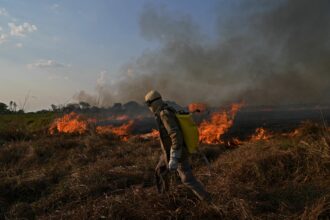The Biden administration cleared the way on Wednesday for a controversial Arctic oil project, recommending that drilling proceed in an undeveloped section of the Alaskan tundra.
While the Bureau of Land Management, or BLM, suggested that the project move forward with a more limited footprint, the changes would still allow ConocoPhillips, the company behind the development, to extract the full volume of oil it is targeting.
The recommendation came in a final environmental impact statement and does not represent the final approval of the project, a decision that environmental advocates say ultimately rests with President Joe Biden.
“We are calling on President Biden to reverse course on this massive climate disaster,” said Kristen Miller, executive director of Alaska Wilderness League, in a statement. “Our window to act is rapidly closing to avert catastrophic climate change, and this plan only takes us one giant step closer to the edge.”
A final decision is expected in the coming weeks.
The Willow Project would represent a major expansion of Alaska’s Arctic oil development and has sparked years of fierce debate as it has churned through the regulatory process and court battles. The project would lie within the National Petroleum Reserve in Alaska, a 23-million acre area managed by the BLM that was set aside in 1923 as an emergency oil supply for the Navy.
Environmental advocates and some Indigenous groups have said that new development in the fragile and rapidly-warming Arctic blatantly contradicts the Biden administration’s broader climate goals.
Alaska’s Congressional delegation, including Sen. Lisa Murkowski, a moderate Republican whom Biden has tried to maintain as an ally in the Senate, has pressed for the administration to approve the project. Sen. Joe Manchin, the West Virginia Democrat and a critical swing vote on Biden’s climate agenda in Congress, has also pushed for Willow’s approval.
The final environmental impact statement, published Wednesday by the BLM, recommended limiting the scope of the project to three well pads initially containing more than 200 wells, with the possibility for adding a fourth pad later. ConocoPhillips had proposed drilling from five well pads.
The bureau said the changes would reduce surface impacts within the Teshekpuk Lake Special Area, critical habitat for thousands of migratory birds and a calving area of the Teshekpuk caribou herd, on which local Indigenous people depend for food. It would also limit the length of roads and pipelines needed, the BLM said.
But the changes would not meaningfully alter how much oil ConocoPhillips would ultimately pump, a peak of more than 180,000 million barrels per day, or more than 600 million barrels over the project’s 30 years of operation. Over that period, the Willow Project would release about 280 million metric tons of climate pollution, equal to running 2.5 average-sized coal power plants for that entire three decades.
Environmental advocates have pointed to repeated scientific reports showing that any new oil expansion is incompatible with the targets of the Paris climate agreement. The Arctic, they have argued, should be considered off limits because it is already warming faster than the global average and is particularly vulnerable to future changes.
“No other oil and gas project has greater potential to undermine the Biden administration’s climate goals, so moving forward with it would be unconscionable,” said Karlin Itchoak, Alaska regional director for The Wilderness Society, in a statement.
While Alaska’s political leaders have said many people in the state support development, Rosemary Ahtuangaruak, the mayor of Nuiqsut, the closest village to the proposed project, has remained steadfastly opposed.
In an op-ed published in The Hill in November, Ahtuangaruak wrote that “[f]or Indigenous people, defending our rights to clean air and water, continuing to live off the land, and protecting the sacredness of Mother Earth is the fight of our lives. Unfortunately, communities like mine continue to be ignored at every turn and are left to fend for ourselves as the devastating effects of our current energy policies destroy our way of life.”
She warned that the development would interrupt the migrations of the caribou and other animals on which her village’s residents depend, and would further pollute the region’s air and water.
Ahtuangaruak could not immediately be reached for comment.
Keep Environmental Journalism Alive
ICN provides award-winning climate coverage free of charge and advertising. We rely on donations from readers like you to keep going.
Donate NowConocoPhillips already operates other oil developments closer to Nuiqsut, and some in the community have long suspected that a rise in respiratory illnesses are linked to that drilling.
In a press release, Erec Isaacson, president of ConocoPhillips Alaska, said the project would benefit local communities with jobs and revenue and help energy security. “ConocoPhillips looks forward to a final record of decision,” he said, “and is ready to begin construction immediately after receiving” final approval.
The project was first approved by the Trump administration, but that decision was overturned by a federal judge in 2021, sending the proposal back to the BLM for further review. Many opponents of the project hoped the Biden administration would reject the project after the president campaigned on a promise to halt all new oil and gas drilling on public lands.
But the war in Ukraine, which upended energy markets and sent oil prices soaring, and political pressure from Republicans and the oil industry have forced the Biden administration to allow some drilling to proceed. ConocoPhillips lobbied heavily in Washington, D.C. last year, spending $8.7 million to influence federal agencies and Congress, more than it had spent over the previous two years combined, according to OpenSecrets, which tracks political spending.
In December, members of Alaska’s Congressional delegation said they had received a promise the final decision would come before the end of February, but on Wednesday the BLM said it would come no sooner than early March.
If the administration does approve the project it could face more challenges from environmentalists who have already successfully tied up Willow in previous court battles, said Jeremy Lieb, a senior attorney at Earthjustice, an environmental law firm.
“It’s fair to assume that if the administration approves the project” without substantial changes, he said, “that another lawsuit is likely to follow.”













